RA HA JEWELRY
Julia Sullivan
[2010, Printmaking]
Based in Providence, RI
“RA HA” can be translated as “Sun Flesh.” The precious metals and stones it is made from become a part of the body and elevate the wearer. RA HA Jewelry is designed and created in Providence, RI and worn around the world.
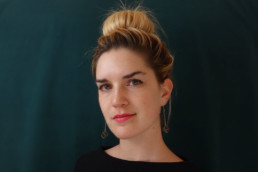
What are some of the most important practices for your creative process?
These earrings are made by hand, either carved from wax or essentially “drawn” with wire. I use needle nose round and flat pliers to shape each piece by hand from wire. This allows me to create curves and angles that are unique in jewelry.
How does your current creative practice tie into your time spent at RISD?
I view my earrings as wire drawings and wearable fine art sculptures. At RISD majoring in Printmaking combined my interests in drawing, metal working and photography. Jewelry is a different way of combining these interests. My background in drawing and this process driven technique gives my jewelry a unique style that incorporates linear mark-making and two dimensional imagery.
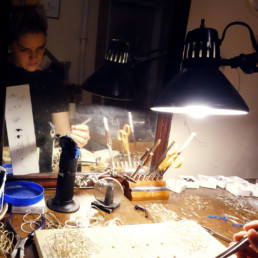
Tell us about some of your main sources of inspiration.
Inspiration for RA HA Jewelry is drawn from natural forms, botanical, animal or human. Many are inspired by leaves and plant parts and some by the celebration and power of the female form among other things.
Is there a work/body of work that you are particularly excited about sharing with us at RISD Craft this year?
This year I will be sharing a new line of jewelry inspired by botanical elements incorporating precious metals as well as powder coating techniques.
Any recent press, exhibitions, achievements or awards you’d like to share with us?
This year RA HA Jewelry was a recipient of the 2018 Providence Design Catalyst Grant from DesignxRI. I have been featured in press including Vogue España and Providence Business News among others. Additionally RA HA Jewelry has expanded sales across the country and the world.

To see more of Julia’s work, visit rahajewelry.com
GLAZE
Akeem Glaze [2012, Industrial Design] +
Stephanie DelVecchio [2012, Industrial Design]
Based in New York, NY
We create lifestyle products designed with distinct attention to detail, and an emotive experience in mind.
We launched our studio, glaze, in 2017 and our first product introduction was a handmade wooden matchbox. It is a statement piece for the home, and an art object that amplifies the experience of striking a match. We make each matchbox by hand with wood sourced from American lumberyards. Our process begins with cutting all wooden components to precise dimensions, and assembling and sanding each box down to a perfect tolerance. We then finish each matchbox with clear polyurethane, buff the exterior, paint the interior, apply a striking surface, and stuff with custom cut matches.

What are some of the most important practices for your creative process?
Our attention to detail is of utmost importance in our product creation process. Every decision we make in regards to form, color, material, etc tells a story and is designed to create a unique emotive product experience.
How does your current creative practice tie into your time spent at RISD?
RISD has taught us to approach our projects as artists, and to execute them as designers. At RISD, we learned the fundamentals of form and the importance of implementing design thinking into problem solving. As Industrial Design majors, we also learned how to work with our hands and hone our craftsmanship, which is imperative to what we make today.


Tell us about some of your main sources of inspiration.
Nice cars, beautiful beaches, and good music. We combine Palm Beach with the Northeast, so we look at both lifestyles as our main sources of inspiration for colors and materials. Akeem filters everything through what he has coined the “comfy country club lifestyle.” Traveling and escaping our day-to-day is also important to keep our minds fresh and to spark new ideas. We live right next to the Botanical Gardens in Brooklyn, and even a brief escape from the city to spend an hour in the garden always triggers inspiration.
Is there a work/body of work that you are particularly excited about sharing with us at RISD Craft this year?
We are most excited to share our U Candle at RISD Craft this year. It is a hand-poured, dual-burning, 100% white beeswax candle that is secured in place with a hand-polished brass holder. It is a play on form, and a reinterpretation of how a conventional taper candle is secured – from the top-down instead of from the bottom-up. We are also very excited to share our two new matchbox additions – Birdseye Maple and Purpleheart.
DOVECOTE COLLECTIVE
Helen Quinn
[1991, Textiles]
Based in Queens, NY
Dovecote Collective is a collaboration between printmakers Ondine Crispin and Helen Quinn. Ondine works primarily with woodblock and linocuts. She is in awe of the perfection of the natural world, especially birds. Helen makes ink drawings that are then made into silkscreens. She prefers creatures of the sea, monsters and alchemical imagery. Together they make textiles for the home as well as fine art prints.
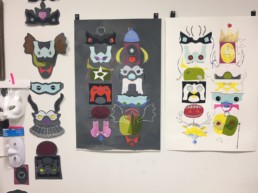
What are some of the most important practices for your creative process?
It takes quite a bit of time, but I love looking at disparate things and then combining them in a kind of salad of imagery. Everything informs us and I find that it is about sifting through sources and experiences to see what sticks. Drawing in a sketchbook and photographing with my phone are quick and helpful when walking down the street or going to a museum. Then back in the studio, cutting paper and drawing with ink often come next, followed by silkscreening in a rented studio space. I often put the finishing touches on prints with gouache so they become one of a kind in the end.
How does your current creative practice tie into your time spent at RISD?
Yes! I first learned to silkscreen at RISD on the wonderful, long tables in the textile department. Also, the Nature Lab continues to be a source of inspiration. Drawing in the Nature Lab all those years ago laid the foundation for so much of what I still do- observing nature and combining the attributes of different creatures.
Tell us about some of your main sources of inspiration.
Lately I have been looking at masks, masquerade balls, photos of crowds of people protesting, and the paintings of masked crowds by 19th century artist James Ensor. After playing with silkscreened images of crowds, I have recently started to concentrate only on the masks and stacking them like the totem poles that were were made by Northwest Indian tribes of British Columbia and southeastern Alaska. I love the verticality of the stacking. It seems like another kind of crowd and the prints together are starting to become a taxonomy of the different characters. (The images below are silkscreen on paper with gouache and collage.)
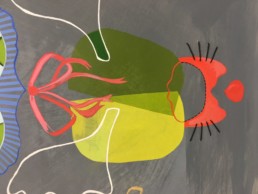
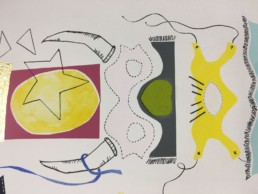
Is there a work/body of work that you are particularly excited about sharing with us at RISD Craft this year?
At RISD Craft, my collaborator Ondine Crispin and I will have silkscreened textiles for the home featuring creatures of the sky and sea. We will also have fine art prints of birds, underwater scenes and my new, strange mask prints.
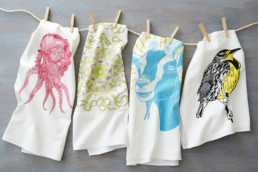
Any recent press, exhibitions, achievements or awards you’d like to share with us?
In May 2018 I will be going to a residency in Oaxaca, Mexico to study the Zapotec sculptures from the archeological site, Monte Alban. The residency is called Poco a Poco and I am really excited about this trip. I think the feathered head dresses and the large jewlry on the figures will be interesting to add to the masks I have been working on.
To see more of the work from Dovecote Collective, visit dovecotecollective.com
COURTNEY WINDHAM DESIGN
What are some of the most important practices for your creative process?
Collecting reference material is an important part of my process. I frequently take time to add inspiration and visual references to a book I keep on my desk in my work space. I photocopy images out of books, cut images out of magazines, collect items like logos, letterforms, sketches, color palettes and tape them into the pages of the book. I refer back to this collection every time I need some quick visual inspiration to stir up ideas. I also keep a few flat file drawers reserved for collecting paper, magazine pages, pages out of old books, recycled print outs, imagery from old calendars and more.
Keeping my work space interesting is important as well. In my office I have a wall dedicated to hanging current work or inspiration. This way I’m able to glance at recent pieces and evaluate their progress. Check out this video I created to show my process from collecting references to collaging to block printing.

How does your current creative practice tie into your time spent at RISD?
I earned a degree in Illustration from RISD. Studying illustration allowed me to develop a sharp eye for everything from composition to storytelling. Through the process of learning to draw, paint, collect research and develop concepts, I obtained a valuable foundation for design.
In 2009, I earned a masters degree in graphic design. I now teach web design, kinetic typography, package design and branding at Auburn University’s School of Industrial + Graphic Design in Auburn, Alabama. Skills learned from a foundation in illustration are always at play in my teaching and personal design work. In the past few years, I have developed a body of work that includes collage and block printing. These hand made processes help me to develop ideas for other design work like posters or animations.

Tell us about some of your main sources of inspiration.
Patterns in nature have been a big influence on my thinking and process of developing my collages and block prints. In fact, as a student at RISD I was highly influenced by the Nature Lab. I also grew up in a wooded area in Birmingham, Alabama. At an early age I was roaming around in nature discovering all types of shapes, patterns, and wild life.
In addition, wherever I travel I take photographs of patterns I see in a city or in nature. For example, I collect photos of patterns and shapes in architectural elements (ex: walls, brick, iron railing), landscapes (ex: leaves, plants, light), textiles or anything else I discover.
Is there a work/body of work that you are particularly excited about sharing with us at RISD Craft this year?
This is my first year to apply to RISD Craft and my first time exhibiting! I’m really excited to show my current body of work because it is an experiment in pattern design. The works I am creating are studies of line, shape and letterforms for the purpose of developing a series of patterns for textiles. Though these prints are intended to be the beginning of a process, they have become pieces of art in themselves. They can be enjoyed by others even if they are initial studies for further development in my process.
Any recent press, exhibitions, achievements or awards you’d like to share with us?
This past year I was featured in GDUSA Magazine’s Educator-to-Watch issue. It was an honor to be included among legends like Richard Wilde, Mary Scott, Phil Hamlett and Ellen Lupton. Over the last couple of years my design work has been published in a variety of design magazines and books. My posters, websites, collages and logos have been published online and in PRINT Magazine, HOW Magazine, Graphis Design Journal, several Creative Quarterly Journals and LogoLounge Volume 9. Also, this summer I received a competitive design fellowship from the Alabama State Council on the Arts. I’m looking forward to utilizing this grant to further my research in design.
Anything else you’d like to share?
Check out Bon Appetype Shop online at www.bonappetypeshop.com — This is my block printing website which includes a process video and examples of prints and patterns. For more of my professional design work take a look at my design portfolio on www.courtneywindhamdesign.com.

To see more of Courtney’s work, visit bonappetypeshop.com and courtneywindhamdesign.com.
ANNE DEPASQUALE MILLINERY
Anne DePasquale
[1993, Textiles]
Based in New York, NY
Innovation and attention to impeccable details is my work is a driving force. I create one-of-a-kind accessories combining classic millinery techniques and shapes with cutting-edge details. Tie-dye, gold leafing, graffiti and unconventional materials like 35mm film, define the signature Anne DePasquale new vintage style.
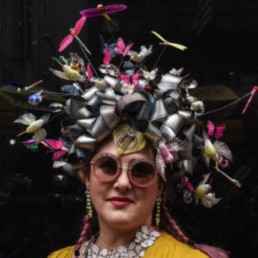
How does your current creative practice tie into your time spent at RISD?
At RISD we were encouraged to explore our creativity while developing our critical thinking skills. In my work, I strive to push the boundaries of traditional headwear to create accessories that stem from those traditions, while creating something fresh and new each season. I use classic techniques, incorporating unconventional materials in many designs. One of my signature collections features 35mm film as headwear. I use my textile training to create other signature hat collections utilizing gold leafing and tie-dying of hats. I am currently in the process of integrating a Latch Hooking tapestry tecnique into my new collections. Additionally, I am creating a new line of printed textiles to highlight my 2019 Collections.
What are some of the most important practices for your creative process?
There is no shortage of inspiration to draw from in NYC. The people, the art, the architecture, the energy – all create a vibe that helps me form ideas. My process is to explore life through childlike eyes, as if everything is new. Every day, I try and view the “ordinary” from a new perspective. Sleep is also very important in my creative process. Often I come up with my best ideas either right before I fall asleep, or as I am waking. I harness my intuition and then try to breathe life into it. Sometimes the piece turns out just as imagined, and sometimes it doesn’t. Sometimes what seems to be a mistake becomes my favorite piece. I stay open to the process and to my craft.
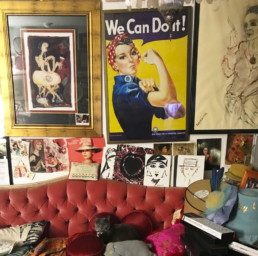
Tell us about some of your main sources of inspiration.
My current main source of inspiration is juxtaposing nature and city elements. Flowers are a huge design element for my festive fascinators for Kentucky Derby and Central Park Conservancy headwear. I am particularly fascinated by the colors of the sunset sky as they reflect on the hard lines of the Manhattan skyscrapers.
Is there a work/body of work that you are particularly excited about sharing with us at RISD Craft this year?
This year for my Fall/Winter Collections I am working with a new technique generally used for rugs called Punch Rug Hooking. I’m using this technique to put a new twist onto my classic 1920’s inspired cloche hats. This collection will be a tapestry of Art Deco design details, and a palette inspired by seasonal changes in New England.
Any recent press, exhibitions, achievements or awards you’d like to share with us?
I am quite excited about numerous shows I worked on this year. I made hats for My Fair Lady which just won the Tony for best costume design. I also made hats for Frozen on Broadway, Come From Away, and The Cher Show, designed by Bob Mackie. It was a dream come true to work with the legendary designer. I am also excited to expand my business. In addition to online and RISDCraft, this year I will be showing at Pop-Up Shop’s and art shows in and around NYC. Check my instagram for show details @AnneDePasquale.
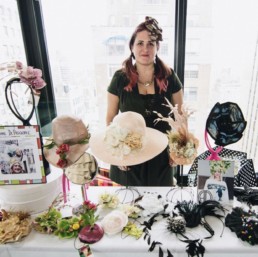
To see more of Anne’s work, visit annedepasquale.com
KARENNA MARAJ JEWELRY
Karenna Maraj
[2005, Jewelry & Metalsmithing]
Based in Belmont, MA
Karenna Maraj creates distinctive industrial jewelry from washers and circular shapes. Each piece is hand worked in her studio in Belmont, MA. The jewelry ranges from light and delicate to deliberate and bold. She is inspired by her passion of everything jewelry and by the exploration of endless possibilities. Her designs showcase the circular elements, and make women feel special, unique and beautiful.
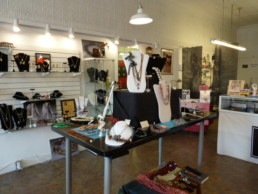
What are some of the most important practices for your creative process?
The most helpful way for me to be creative is to work and make a piece. As I create a particular piece of jewelry, ideas begin to form about a new way to assemble those same parts. I usually like to make sketches as I go if I have many ideas, and if I’m very excited about an idea, I frequently will quickly make a sample and put it for sale in my store. By doing this, I can get feedback and see what people think of the piece. I’ve been established in one location for 8 years, so my customers are very helpful because they have seen my work progress and they give me helpful, thoughtful and honest opinions.

How does your current creative practice tie into your time spent at RISD?
All of my current production work is inspired by my thesis project at RISD. In school I made a series of 7 necklaces with industrial washers and handmade circles. These necklaces were large and heavy- not for everyday wear. I decided upon the most interesting aspects of each of the necklaces and held those sacred, but transformed the necklace into a more practical weight and versatile design. They’ve since evolved into pendants and earrings and bracelets. So now there are styles for everyone.
Is there a work/body of work that you are particularly excited about sharing with us at RISD Craft this year?
I am most excited about my compression collection. This original design style centers around a series of handmade copper circles that have been hammered and sometimes oxidized, then made into a series of necklaces and earrings. This collection has been my most popular, especially if I combine washers with the compression. My favorite pendant also has freshwater pearls with the oxidized copper and comes with an option of two different seed beads.
To see more of Karenna Maraj’s work, visit karennamarajcollection.com
ANCHORPAK
In Maine, ingenuity and resourcefulness are part of our character. We have all sorts of wicked weather and rough terrain to navigate and as a result we have learned to tinker with things to make life go better. It was in this tradition that Anchorpak’s founder, Colin Sullivan-Stevens, a Maine native and Rhode Island School of Design graduate, designed the Anchorpack. He needed something to carry all his stuff to his studio on his bicycle. It needed to feature accessibility, hands free carrying, stability and comfort. Using an old movie screen for material and his geometric expertise from studies in acoustics, he designed and stitched together his first Anchorpak.
It is in the spirit of local community and environmental awareness that Anchorpak manufactures all products in Maine. Maine is a state with a long tradition of quality textile manufacturing but over the years they have lost many jobs to overseas manufacturing. Anchorpak aims to do their part to restore this valuable skill set and employment sector to Maine, and source materials in the USA.

What are some of the most important practices for your creative process?
Brainstorming: My approach to small and large decisions is to attempt to work out flexible connections between the concrete functional aspects at play and the multifaceted soup of ideas and experiences kicking around upstairs. I try to store up on the possibilities even when ideas and things don’t connect because storage is free.

How does your current creative practice tie into your time spent at RISD?
From my current perspective as a designer working outside my field study at RISD which was painting, I was not too surprised to shift my creative practice to address the ergonomic design of bags. The sense that there is always more to understand about everything, that solutions to creative challenges are unlimited if enough focus and hard work are put forth was implicit at RISD and remains the basis from which I begin my work everyday.
Is there a work/body of work that you are particularly excited about sharing with us at RISD Craft this year?
Yes, I am looking forward to being back on Benefit Street to share a design invention I’ve dubbed The Anchorpak bag. I have a feeling that it might appeal in the RISD community where can develops an eye for simple effective product design.
Tell us about some of your main sources of inspiration.
Childhood/Nature: butterflies, building “forts” in the snow and in the woods, downhill skiing, whale watching, flying an airplane at age 11 and The Space Shuttle. Later on… free-jazz, Bjork, the earth, nature and hearty mysteries, food, good civics and well balanced design systems, uncertainty and humanistic ideals.

Any recent press, exhibitions, achievements or awards you’d like to share with us?
Anchorpak has been granted funds by the Maine State Technology Institute in 2015, 2016, 2017 to understand and develop our innovative ergonomic bag design concept for improved everyday carrying. We have been featured in NE regional press often including The Boston Globe and Downeast Magazine editorials, Maine Biz and Old Port Magazine entrepreneur/artist /designer profiles.
Visit anchorpak.com to see more!
BELA MONDE
Lisa Limer
[1977, Photography]
Based in Pawtucket, RI
Bela Monde’s RISD Craft Gallery
Bela Monde is an accessory/lifestyle company and is a natural out growth of my professional life as a travel photographer. For over 20 years I was under contract as a photographer with Conde Nast Traveler and collaborated with other national and international publications as a freelancer. My textiles originate from this archive of photographs taken from around the world. I transform my photographs into abstracted designs that are both sophisticated and representative of the destination that inspired its creation.
How does your current creative practice tie into your time spent at RISD?
I directly transform elements from my extensive archive of photographs to create my textile designs which are then digitally printed onto 100% silk.

What are some of the most important practices for your creative process?
Using photoshop to identify elements in my photographs and transform them in such a way as to reflect a particular culture/destination. Digitally printing on silk these patterns and sewing them by hand to create wearable art: scarves, caftans, robes, and pajamas.

Tell us about some of your main sources of inspiration.
I believe that travel is a transformative experience. I use my extensive travel from around the world as a travel photographer for prestigious magazines……40 countries on 6 continents in over 15 years….as my means to create wearable art that express my story, inspiration and respect for global cultures.
Is there a work/body of work that you are particularly excited about sharing with us at RISD Craft this year?
I will be exhibiting our new loungewear collection of robes and pajamas as well as scarves–all 100% silk, sewn locally and 100% American made. Our new collection draws its inspiration from India, Laos, Thailand, Morocco and Spain.
Any recent press, exhibitions, achievements or awards you’d like to share with us?
To see more of Lisa’s work, visit belamonde.com

ANASTASIA AZURE
Tell us about some of your main sources of inspiration.
The elegance of geometry is my main source of inspiration. I am particularly drawn to radial symmetry and its ability to provide serenity. I merge the disciplines of jewelry metal arts and textiles to explore mathematical shapes and scientific principles. I toggle back and forth in size between bold, wearable jewelry and geometric, wall sculptures. I use an ancient Peruvian weaving technique that I have adapted to a floor loom and weave with nylon and wire.

Is there a work/body of work that you are particularly excited about sharing with us at RISD Craft this year?
I am thrilled to debut my Dimensional Weave Jewelry collection with the RISD community this year. I handcraft contemporary art jewelry by combining textiles and jewelry metal arts with non-traditional materials. The jewelry is very detailed, complicated and time intensive to make. I do very limited production throughout the year. RISD Craft will be my exclusive retail event of 2018.

Any recent press, exhibitions, achievements or awards you’d like to share with us?
EXCERPT FROM MY UPCOMING PRESS RELEASE: Anastasia’s innovative artwork attracted the eye of a Hungarian art consultant on Instagram, leading to her largest project to date. Fifteen woven wall sculptures were commissioned for an overseas installation! This led to the expansion of her studio at the Hope Artiste Village in Pawtucket, RI, a harmoniously designed space for production and exhibition.
Her largest international project will proudly be displayed in the newly built Grand Hyatt, Abu Dhabi, United Arab Emirates, slated to open its doors late summer 2018. The 5-star property will display Anastasia’s architectural, interior décor in the atrium lobby among many other works by respected artists. Additional sculptural work by Anastasia can be found in the Ritz Carlton – Half Moon Bay, CA, and the Hilton in Singapore.

To see more of Anastasia Azure’s work, visit anastasiaazure.com
RICHARD HAINING
Richard Haining
[2005, Furniture]
Based in New York, NY
*People’s Choice Award winner [RISD Craft 2015]
How does your current creative practice tie into your time spent at RISD?
RISD introduced me to the work of some amazing artists. George Nakashima’s understanding of material’s inherent soul, the stack laminating and subsequent hand carving seen in Wendell Castle’s work, and Andrew Goldsworthy’s premise of taking materials as you find them to create new work are all a constant source of inspiration.

What are some of the most important practices for your creative process?
RISD instilled in me the importance of problem solving in all aspects of the creative process (regardless of major, medium, or situation). But, patience is required to successfully problem solve. Patience does not always come easy to me, but my chosen work is a very methodical and meditative process that is a constant reminder me of the importance of patience.

Tell us about some of your main sources of inspiration.
Waste was the initial source of my inspiration. My current body of work, STACKED, uses salvaged wood. When I first started making STACKED pieces, it was due to lack of financial resources. But very quickly I became engrossed in the challenge of using very small parts to create a larger whole. There is such an over-abundance of scrap wood being thrown out in local woodshops and from the plethora of pre-war building materials being trashed from NYC’s architectural landscape. This material other people deemed “waste” was in my eye perfectly good, and became the building blocks for my work. Using salvaged wood just requires a bit more time and patience to create the finished piece. I love that my process allows me to create something that cannot be found in nature. There is no burl or spalting that will ever match the mosaic quality my finished pieces take on. Unlike segmented work, I have no preplanned math. Since I build piece-by-piece, layer by layer, the result is an insanely beautiful random patterning. My choice of sculpting the exterior of each piece by hand (there is no lathe work on any of my work) results in a finished surface with subtle undulations similar to that of hand built pottery.
Any recent press, exhibitions, achievements or awards you’d like to share with us?
I was recently commissioned by ASID’s NY Metro Chapter to design and create 10 awards for their 2018 Honors Gala which took place at the Conde Nast office’s in One World Trade Center.
I also received an award from the James Renwick Alliance for Innovation in Craft at the American Craft Council Show in Baltimore back in February of this year.

To see more of Richard Haining’s work, visit richardhaining.com


